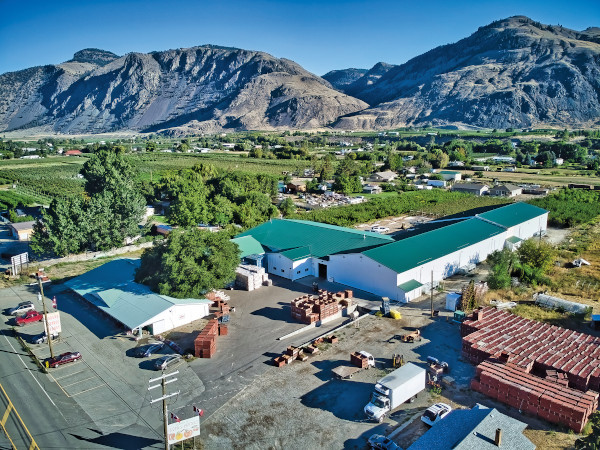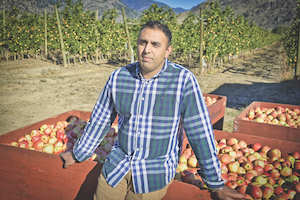
By Trevor Bacque
Gurpreet Lidder wouldn’t be the first farm kid with plans of escape. Only the further he ran, the better that rear-view image looked to him. “When you grow up on a farm, you’re taught to do well, get an education and you’ll get this great job in an office, but for me it was the opposite,” says Lidder. “When I got to that stage I wasn’t satisfied. I missed the whole farming lifestyle and where I grew up.”
That place was Keremeos, BC, where his parents had established a 10-acre fruit farm in 1992, a few years after emigrating from India. Today, Lidder Farms covers 240 acres and markets fruit — mainly apples, but also cherries, apricots, peaches and more — in grocery stores from coast to coast under the Lidder’s Produce banner.
That journey, from farm kid to farm boss, wasn’t always smooth for Lidder. But taking risks and making mistakes can teach a person as much about successfully running a business as a university degree can, and Lidder has relied on it all to help build the family farm into what it is today.
EXPANDING THE FARM
While getting his business degree at the University of British Columbia, Lidder would come home summers and apply various principles he learned at school to the business. For instance, he brought real-time sales tracking to the shop and showed his parents the raw data of what was selling, what wasn’t and at what rate, along with other timely information.
By the time he graduated in 2006, Lidder knew he would come home and eventually succeed his parents. Even though he had been making decisions for the business since he was a teen — with his parents’ support and trust — that first six years after university marked a major learning curve and growth phase for Lidder and the business.
One of the biggest and scariest decisions was buying more land. In 2012, a neighbour offered Lidder and his uncle first right of refusal on 165 acres of bare land. Lidder was keenly interested in a few parcels, but that did not suit the seller — it was all or nothing. So Lidder went to the bank, which initially said it would help finance the purchase, then later backed out, saying it was too risky because the land was unplanted.
But it was too good an opportunity to pass up, so they purchased it without the bank’s help and planted it to super spindle apple trees, which can be planted at higher densities because they need very little space between them. Lidder says that when he was a teen, a typical apple farm may have planted 300 trees per acre, but with the super spindles, 2,200 trees per acre is normal.
Newly planted fruit trees take time to start producing, so 165 acres of new trees to tend with no crop to speak of was a huge financial risk for the Lidders, particularly after the bank backed away. It took six years for production to finally come in, and at sizable rates, which was a huge step forward for the business. Today, a typical farm-wide harvest for Lidder is about six million pounds of apples, or about 25 million apples in total.

Gurpreet’s biggest risk was purchasing 165 acres from a neighbour, without the bank’s help, to plant super spindle apple trees that took six years to come in.
EXPANDING THE MARKET
Once the new trees were producing, Lidder had a choice to make; continue to sell to the co-op that his parents had so dutifully worked with for years, or blaze a new trail. As Lidder began to explore and build new marketing relationships, tensions arose with their long-time, primary buyer.
“They weren’t going to let us do both,” he says. “Their attitude was: you’re with us or you’re against us. We were like, ‘OK let’s take a chance on ourselves and see what we can do with selling our product directly.'” It turns out they could do a lot.
Lidder was already selling direct to some B.C. retailers when he found himself assuring Loblaws that he could deliver fiveplus quality apple types throughout the year. He secured the deal, but his packing plant wasn’t even built yet.

“When you grow up on a farm, you’re taught to do well, get an education and you’ll get this great job in an office but for me it was the opposite. When I got to that stage I wasn’t satisfied. I missed the whole farming lifestyle and where I grew up”
GURPREET LIDDER
“At the time, I was at a point where we needed to expand,” he says. “We didn’t even have enough space to fill our existing customers.” The deal was motivation to step on the gas and the family built a brand new, 25,000 sq. ft. facility to process, package and cold store apples.
“You never know what’s going to happen, I just told my story and a VP within Loblaws gave me a chance,” he explains. “I didn’t even have a packing house at that point. When they visited, it was like, I’m going to do this, this and this and they backed it. They gave me the opportunity and I went with it.”
The packing house opened an international opportunity, too. Many of the apples the Lidders produce are considered oversized — a turn-off for Canadian consumers. However, bigger does mean better in countries such as Vietnam, Malaysia and Thailand, which happen to be some of the biggest apple markets on Earth. Here, Lidder’s products net 30 per cent or more margin compared to his domestic sales.
A major change that came with moving to a direct marketing strategy was improved cash flow. Lidder says that the co-operative would sometimes take a year or more to pay. By marketing their produce directly, national and international buyers pay on a regular vendor schedule. “When any business has money coming in, you can allocate more to your next crop,” he says.
The risk/reward ratio was big and Lidder went all in on the risk. But has it paid off? Today, Lidder’s Farms’ apples can be purchased from Victoria to St. John’s all year long in every single Sobeys, Loblaws and many independents.
LEADING THE PACK
Today, Lidder, who is B.C.’s Outstanding Young Farmer for 2022, continues to differentiate the farm by conducting yearround soil, leaf and fruit tests.
His chief horticulturist, Kathryn Miskulin, studies one- to five-acre blocks at a time and makes real time assessments of what the trees in that block need. It’s an approach akin to variable rate application in field crops, where defined areas of the farm are tested and treated rather than broadcast treat the entire acreage.
“We make changes on things all the time within the season, immediately or after, depending on how big the variance is,” Lidder says. “If we see a deficiency on a leaf analysis, we will change it.” For instance, if tests show that a block of trees has calcium deficiency, that block is treated immediately. “It seems like it’s more work, but we spend less. We’re giving the tree exactly what it needs versus a broadcast of what it needs.”
Over the last 30 years, apple production in B.C. has shrunk from more than 20,000 acres to less than 7,000 acres. During the same period, the Lidder farm has produced increasingly more fruit, something he takes great pride in because constantly driving to improve and taking risks is not easy.
“I got shut down a lot,” says Lidder. “People won’t give you chance, won’t take your product, or are not interested. Just giving up is not the answer. You have to keep pressing. I know the opportunities in ag will come because there’s just such a high need for it. If you’re passionate, the hard days are never really that hard.”